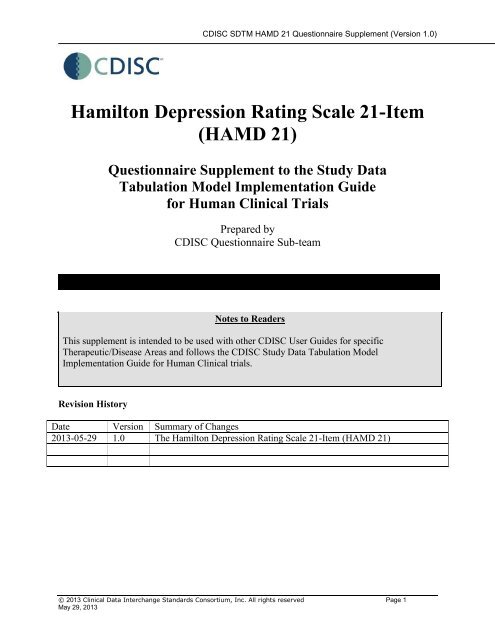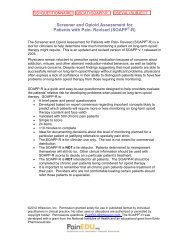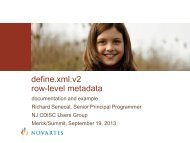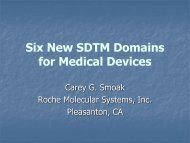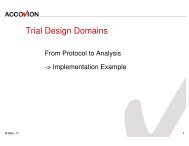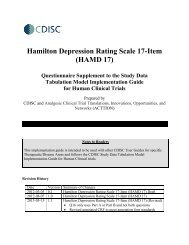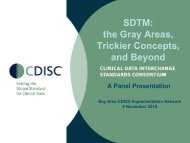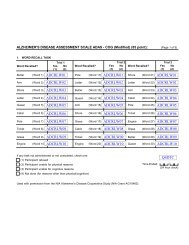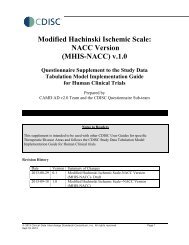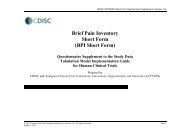Hamilton Depression Rating Scale 21-Item (HAMD 21)
HAMD 21 v1 Public Domain - CDISC Portal
HAMD 21 v1 Public Domain - CDISC Portal
- No tags were found...
You also want an ePaper? Increase the reach of your titles
YUMPU automatically turns print PDFs into web optimized ePapers that Google loves.
CDISC SDTM <strong>HAMD</strong> <strong>21</strong> Questionnaire Supplement (Version 1.0)<br />
<strong>Hamilton</strong> <strong>Depression</strong> <strong>Rating</strong> <strong>Scale</strong> <strong>21</strong>-<strong>Item</strong><br />
(<strong>HAMD</strong> <strong>21</strong>)<br />
Questionnaire Supplement to the Study Data<br />
Tabulation Model Implementation Guide<br />
for Human Clinical Trials<br />
Prepared by<br />
CDISC Questionnaire Sub-team<br />
Notes to Readers<br />
This supplement is intended to be used with other CDISC User Guides for specific<br />
Therapeutic/Disease Areas and follows the CDISC Study Data Tabulation Model<br />
Implementation Guide for Human Clinical trials.<br />
Revision History<br />
Date Version Summary of Changes<br />
2013-05-29 1.0 The <strong>Hamilton</strong> <strong>Depression</strong> <strong>Rating</strong> <strong>Scale</strong> <strong>21</strong>-<strong>Item</strong> (<strong>HAMD</strong> <strong>21</strong>)<br />
© 2013 Clinical Data Interchange Standards Consortium, Inc. All rights reserved Page 1<br />
May 29, 2013
CDISC SDTM <strong>HAMD</strong> <strong>21</strong> Questionnaire Supplement (Version 1.0)<br />
1 Introduction<br />
This document describes the CDISC implementation of the <strong>Hamilton</strong> <strong>Depression</strong> <strong>Rating</strong> <strong>Scale</strong><br />
<strong>21</strong>-<strong>Item</strong> (<strong>HAMD</strong> <strong>21</strong>) questionnaire, a standard questionnaire that is typically used in clinical<br />
trials to rate the severity of depression in patients who are already diagnosed as depressed.<br />
The <strong>HAMD</strong> <strong>21</strong> questionnaire preceded the CDISC CDASH CRF standards and based on its<br />
public domain status, cannot be modified to CDASH standards.<br />
The representation of data collected for this questionnaire is based on the Study Data Tabulation<br />
Model Implementation Guide (SDTMIG) QS domain model, which can be found at the CDISC<br />
website at: (http://www.cdisc.org/sdtm).<br />
These specific implementation details for this questionnaire are meant to be used in conjunction<br />
with the SDTMIG. All questionnaire documentation can be found on the CDISC web site at:<br />
(http://www.cdisc.org/content2909).<br />
The CDISC Intellectual Property Policy can be found on the CDISC web site at:<br />
(http://www.cdisc.org/bylaws-and-policies).<br />
1.1 Representations and Warranties, Limitations of Liability, and Disclaimers<br />
This document is a supplement to the Study Data Tabulation Model Implementation Guide for<br />
Human Clinical Trials and is covered under Appendix F of that document, which describes<br />
representations, warranties, limitations of liability, and disclaimers. Please see Appendix F of<br />
the SDTMIG for a complete version of this material.<br />
2 Copyright Status<br />
This instrument is in the public domain. CDISC has included the <strong>Hamilton</strong> <strong>Rating</strong> <strong>Scale</strong> <strong>21</strong>-<strong>Item</strong><br />
(<strong>HAMD</strong> <strong>21</strong>) as part of CDISC Data Standards. Hence, CDISC developed QSTESTCD and QSTEST<br />
for each question based on the actual question text on the questionnaire. There may be many versions<br />
of this questionnaire in the public domain. CDISC has chosen to use this version as the data standard.<br />
The CDISC documentation of this instrument consists of: (1) controlled terminology, (2)<br />
standard database structure with examples, and (3) case report forms annotated with the CDISC<br />
SDTMIG submission values.<br />
Note: CDISC controlled terminology is maintained by NCI EVS. The most recent version should<br />
be accessed through the CDISC website. (http://www.cdisc.org/terminology)<br />
CDISC has developed this documentation at no cost to users of the instrument.<br />
© 2013 Clinical Data Interchange Standards Consortium, Inc. All rights reserved Page 2<br />
May 29, 2013
3 The QS Domain Model<br />
CDISC SDTM <strong>HAMD</strong> <strong>21</strong> Questionnaire Supplement (Version 1.0)<br />
3.1 Assumptions for Questionnaire Domain Model<br />
All assumptions and business rules described in the SDTMIG QS domain are applicable<br />
to this supplement. Additional assumptions specific to the <strong>Hamilton</strong> <strong>Depression</strong> <strong>Rating</strong><br />
<strong>Scale</strong> <strong>21</strong>-<strong>Item</strong> questionnaire are listed below:<br />
<br />
<br />
<br />
<br />
<br />
<strong>HAMD</strong>-<strong>21</strong> is a multiple choice questionnaire consisting of <strong>21</strong> items, the first 17 of<br />
which are scored. <strong>Rating</strong>s are made during a clinical interview with the subject who<br />
already has been diagnosed as suffering from a depressive disorder.<br />
For item 16, the <strong>HAMD</strong> <strong>21</strong> questionnaire provides two methods by which the<br />
investigator may choose one method to assess the weight loss. For both methods, a<br />
choice of “3 = Not assessed” is present but this value is not included in calculation of<br />
the summary score. Generally, one of the items will be assessed (score of 0, 1, or 2)<br />
and the other will not be assessed (score of 3).<br />
The time period of evaluation for the <strong>HAMD</strong> <strong>21</strong> is populated in the QSEVLINT field in<br />
ISO 8601 format when the evaluation interval can be precisely described as duration.<br />
Typically, the evaluation interval for <strong>HAMD</strong> <strong>21</strong> is the past week.<br />
The questionnaire evaluator should be stored in QSEVAL. For <strong>HAMD</strong> <strong>21</strong>, the<br />
evaluator is usually defined as INVESTIGATOR.<br />
Terminology:<br />
a. QSCAT, QSTESTCD and QSTEST are approved CDISC controlled terminology.<br />
b. A full list of value sets for qualifier, timing, result and unit fields is provided in<br />
Section 4: SDTM Mapping Strategy.<br />
© 2013 Clinical Data Interchange Standards Consortium, Inc. All rights reserved Page 3<br />
May 29, 2013
CDISC SDTM <strong>HAMD</strong> <strong>21</strong> Questionnaire Supplement (Version 1.0)<br />
3.2 Example for <strong>Hamilton</strong> <strong>Depression</strong> <strong>Rating</strong> <strong>Scale</strong> <strong>21</strong>-<strong>Item</strong> (<strong>HAMD</strong> <strong>21</strong>) QS Domain Model<br />
The <strong>HAMD</strong> <strong>21</strong> example below shows the terminology used to implement the questionnaire in the QS domain. This example shows the data for one<br />
subject collected at one visit for the <strong>HAMD</strong> <strong>21</strong> questionnaire. The example uses CDISC controlled terminology for QSTESTCD, QSTEST, and<br />
QSCAT. The expected QS field QSBLFL is not included in this example based on its NULL value at VISITNUM=3.<br />
Rows 1-24: Represent the questions from the <strong>HAMD</strong> <strong>21</strong> form. All original results are represented with preferred terminology in QSORRES. This<br />
result is then transformed into a standard numeric score in QSSTRESN and a character representation of the standard numeric score in QSSTRESC.<br />
The evaluation interval for <strong>HAMD</strong> <strong>21</strong> is the past week, which is stored in QSEVLINT in ISO format.<br />
Row 16 & 17: Illustrates method A for the loss of weight item was assessed and method B was not assessed. For <strong>HAMD</strong><strong>21</strong>6B, this standardized<br />
value of 3 is not included in the calculation of the summary score.<br />
Row 24: Represents the summary score which can either be entered or may be derived via the detailed questions comprising the summary score.<br />
When derived, QSDRVFL is set to “Y”. In this example for the <strong>HAMD</strong> <strong>21</strong>, only the first 17 question are included in the calculation of the<br />
summary score.<br />
QS.XPT<br />
Row STUDYID DOMAIN USUBJID QSSEQ QSTESTCD QSTEST QSCAT QSORRES QSSTRESC QSSTRESN<br />
1 STUDYX QS P0001 1 <strong>HAMD</strong>201 <strong>HAMD</strong>2-Depressed Mood <strong>HAMD</strong> <strong>21</strong> These feeling states indicated only on<br />
questioning<br />
2 STUDYX QS P0001 2 <strong>HAMD</strong>202 <strong>HAMD</strong>2-Feelings of Guilt <strong>HAMD</strong> <strong>21</strong> Present illness is a punishment.<br />
Delusions of guilt<br />
1 1<br />
3 3<br />
3 STUDYX QS P0001 3 <strong>HAMD</strong>203 <strong>HAMD</strong>2-Suicide <strong>HAMD</strong> <strong>21</strong> Absent 0 0<br />
4 STUDYX QS P0001 4 <strong>HAMD</strong>204 <strong>HAMD</strong>2-Insomnia Early <strong>HAMD</strong> <strong>21</strong> No difficulty falling asleep 0 0<br />
5 STUDYX QS P0001 5 <strong>HAMD</strong>205 <strong>HAMD</strong>2-Insomnia Middle <strong>HAMD</strong> <strong>21</strong> Patient complains of being restless and<br />
disturbed during the night<br />
6 STUDYX QS P0001 6 <strong>HAMD</strong>206 <strong>HAMD</strong>2-Insomnia Late <strong>HAMD</strong> <strong>21</strong> Unable to fall asleep again if he gets out<br />
of bed<br />
1 1<br />
2 2<br />
7 STUDYX QS P0001 7 <strong>HAMD</strong>207 <strong>HAMD</strong>2-Work and Activities <strong>HAMD</strong> <strong>21</strong> No difficulty 0 0<br />
8 STUDYX QS P0001 8 <strong>HAMD</strong>208 <strong>HAMD</strong>2-Retardation <strong>HAMD</strong> <strong>21</strong> Normal speech and thought 0 0<br />
9 STUDYX QS P0001 9 <strong>HAMD</strong>209 <strong>HAMD</strong>2-Agitation <strong>HAMD</strong> <strong>21</strong> Playing with hands, hair, etc. 2 2<br />
10 STUDYX QS P0001 10 <strong>HAMD</strong><strong>21</strong>0 <strong>HAMD</strong>2-Anxiety Psychological <strong>HAMD</strong> <strong>21</strong> Subjective tension and irritability 1 1<br />
11 STUDYX QS P0001 11 <strong>HAMD</strong><strong>21</strong>1 <strong>HAMD</strong>2-Anxiety Somatic <strong>HAMD</strong> <strong>21</strong> Severe 3 3<br />
© 2013 Clinical Data Interchange Standards Consortium, Inc. All rights reserved Page 4<br />
May 29, 2013
CDISC SDTM <strong>HAMD</strong> <strong>21</strong> Questionnaire Supplement (Version 1.0)<br />
12 STUDYX QS P0001 12 <strong>HAMD</strong><strong>21</strong>2 <strong>HAMD</strong>2-Somatic Symptoms Gastro-intestinal <strong>HAMD</strong> <strong>21</strong> None 0 0<br />
13 STUDYX QS P0001 13 <strong>HAMD</strong><strong>21</strong>3 <strong>HAMD</strong>2-Somatic Symptoms General <strong>HAMD</strong> <strong>21</strong> None 0 0<br />
14 STUDYX QS P0001 14 <strong>HAMD</strong><strong>21</strong>4 <strong>HAMD</strong>2-Genital Symptoms <strong>HAMD</strong> <strong>21</strong> Mild 1 1<br />
15 STUDYX QS P0001 15 <strong>HAMD</strong><strong>21</strong>5 <strong>HAMD</strong>2-Hypochondriasis <strong>HAMD</strong> <strong>21</strong> Frequent complaints, requests for help, 3 3<br />
etc.<br />
16 STUDYX QS P0001 16 <strong>HAMD</strong><strong>21</strong>6A <strong>HAMD</strong>2-Loss of Weight by History <strong>HAMD</strong> <strong>21</strong> No weight loss 0 0<br />
17 STUDYX QS P0001 17 <strong>HAMD</strong><strong>21</strong>6B <strong>HAMD</strong>2-Loss of Weight Measured <strong>HAMD</strong> <strong>21</strong> Not assessed 3 3<br />
18 STUDYX QS P0001 18 <strong>HAMD</strong><strong>21</strong>7 <strong>HAMD</strong>2-Insight <strong>HAMD</strong> <strong>21</strong> Denies being ill at all 2 2<br />
19 STUDYX QS P0001 19 <strong>HAMD</strong><strong>21</strong>8A <strong>HAMD</strong>2-Diurnal Variation <strong>HAMD</strong> <strong>21</strong> Worse in P.M. 2 2<br />
20 STUDYX QS P0001 20 <strong>HAMD</strong><strong>21</strong>8B <strong>HAMD</strong>2-Diurnal Variation Severity <strong>HAMD</strong> <strong>21</strong> Mild 1 1<br />
<strong>21</strong> STUDYX QS P0001 <strong>21</strong> <strong>HAMD</strong><strong>21</strong>9 <strong>HAMD</strong>2-Depersonalization/Derealization <strong>HAMD</strong> <strong>21</strong> Absent 0 0<br />
22 STUDYX QS P0001 22 <strong>HAMD</strong>220 <strong>HAMD</strong>2-Paranoid Symptoms <strong>HAMD</strong> <strong>21</strong> Suspicious 1 1<br />
23 STUDYX QS P0001 23 <strong>HAMD</strong>2<strong>21</strong> <strong>HAMD</strong>2-Obsessional/Compulsive Symptoms <strong>HAMD</strong> <strong>21</strong> Mild 1 1<br />
24 STUDYX QS P0001 24 <strong>HAMD</strong>222 <strong>HAMD</strong>2-Total Score <strong>HAMD</strong> <strong>21</strong> 19 19 19<br />
Row QSDRVFL QSEVAL VISITNUM QSDTC QSEVLINT<br />
1 (cont) INVESTIGATOR 3 2012-11-16 -P1W<br />
2 (cont) INVESTIGATOR 3 2012-11-16 -P1W<br />
3 (cont) INVESTIGATOR 3 2012-11-16 -P1W<br />
4 (cont) INVESTIGATOR 3 2012-11-16 -P1W<br />
5 (cont) INVESTIGATOR 3 2012-11-16 -P1W<br />
6 (cont) INVESTIGATOR 3 2012-11-16 -P1W<br />
7 (cont) INVESTIGATOR 3 2012-11-16 -P1W<br />
8 (cont) INVESTIGATOR 3 2012-11-16 -P1W<br />
9 (cont) INVESTIGATOR 3 2012-11-16 -P1W<br />
10 (cont) INVESTIGATOR 3 2012-11-16 -P1W<br />
11 (cont) INVESTIGATOR 3 2012-11-16 -P1W<br />
12 (cont) INVESTIGATOR 3 2012-11-16 -P1W<br />
13 (cont) INVESTIGATOR 3 2012-11-16 -P1W<br />
14 (cont) INVESTIGATOR 3 2012-11-16 -P1W<br />
15 (cont) INVESTIGATOR 3 2012-11-16 -P1W<br />
16 (cont) INVESTIGATOR 3 2012-11-16 -P1W<br />
© 2013 Clinical Data Interchange Standards Consortium, Inc. All rights reserved Page 5<br />
May 29, 2013
CDISC SDTM <strong>HAMD</strong> <strong>21</strong> Questionnaire Supplement (Version 1.0)<br />
17 (cont) INVESTIGATOR 3 2012-11-16 -P1W<br />
18 (cont) INVESTIGATOR 3 2012-11-16 -P1W<br />
19 (cont) INVESTIGATOR 3 2012-11-16 -P1W<br />
20 (cont) INVESTIGATOR 3 2012-11-16 -P1W<br />
<strong>21</strong> (cont) INVESTIGATOR 3 2012-11-16 -P1W<br />
22 (cont) INVESTIGATOR 3 2012-11-16 -P1W<br />
23 (cont) INVESTIGATOR 3 2012-11-16 -P1W<br />
24 (cont) Y INVESTIGATOR 3 2012-11-16 -P1W<br />
© 2013 Clinical Data Interchange Standards Consortium, Inc. All rights reserved Page 6<br />
May 29, 2013
CDISC SDTM <strong>HAMD</strong> <strong>21</strong> Questionnaire Supplement (Version 1.0)<br />
4 SDTM Mapping Strategy<br />
<strong>HAMD</strong> <strong>21</strong> specific mapping strategy: This section is used for reference with the annotated CRF<br />
for further details on the CRF data capture and to understand the alignment of the questionnaire<br />
to the SDTM QS domain. It also provides guidance on how the result variables (QSORRES,<br />
QSSTRESC, and QSSTRESN) should be populated for the questionnaire.<br />
QSTESTCD=<strong>HAMD</strong>201 QSTEST=<strong>HAMD</strong>2-Depressed Mood<br />
QSORRES QSSTRESC QSSTRESN<br />
Absent 0 0<br />
These feeling states indicated only on questioning 1 1<br />
These feeling states spontaneously reported verbally 2 2<br />
Communicates feeling states non-verbally - i.e., through<br />
3 3<br />
facial expression, posture, voice and tendency to weep<br />
Patient reports VIRTUALLY ONLY these feeling states in<br />
his spontaneous verbal and non-verbal communication<br />
4 4<br />
QSTESTCD=<strong>HAMD</strong>202 QSTEST=<strong>HAMD</strong>2-Feelings of Guilt<br />
QSORRES QSSTRESC QSSTRESN<br />
Absent 0 0<br />
Self reproach, feels he has let people down 1 1<br />
Ideas of guilt or rumination over past errors or sinful deeds 2 2<br />
Present illness is a punishment. Delusions of guilt 3 3<br />
Hears accusatory or denunciatory voices and/or<br />
experiences threatening visual hallucinations<br />
4 4<br />
QSTESTCD=<strong>HAMD</strong>203 QSTEST=<strong>HAMD</strong>2-Suicide<br />
QSORRES QSSTRESC QSSTRESN<br />
Absent 0 0<br />
Feels life is not worth living 1 1<br />
Wishes he were dead or any thoughts of possible death to<br />
2 2<br />
self<br />
Suicidal ideas or gesture 3 3<br />
Attempts at suicide (any serious attempt rates 4) 4 4<br />
QSTESTCD=<strong>HAMD</strong>204 QSTEST=<strong>HAMD</strong>2-Insomnia Early<br />
QSORRES QSSTRESC QSSTRESN<br />
No difficulty falling asleep 0 0<br />
Complains of occasional difficulty falling asleep - i.e.,<br />
1 1<br />
more than 1/2 hour<br />
Complains of nightly difficulty falling asleep 2 2<br />
QSTESTCD=<strong>HAMD</strong>205 QSTEST=<strong>HAMD</strong>2-Insomnia Middle<br />
QSORRES QSSTRESC QSSTRESN<br />
No difficulty 0 0<br />
Patient complains of being restless and disturbed during<br />
the night<br />
1 1<br />
© 2013 Clinical Data Interchange Standards Consortium, Inc. All rights reserved Page 7<br />
May 29, 2013
CDISC SDTM <strong>HAMD</strong> <strong>21</strong> Questionnaire Supplement (Version 1.0)<br />
Waking during the night – any getting out of bed rates 2<br />
(except for purposes of voiding)<br />
2 2<br />
QSTESTCD=<strong>HAMD</strong>206 QSTEST=<strong>HAMD</strong>2-Insomnia Late<br />
QSORRES QSSTRESC QSSTRESN<br />
No difficulty 0 0<br />
Waking in early hours of the morning but goes back to<br />
1 1<br />
sleep<br />
Unable to fall asleep again if he gets out of bed 2 2<br />
QSTESTCD=<strong>HAMD</strong>207 QSTEST=<strong>HAMD</strong>2-Work and Activities<br />
QSORRES QSSTRESC QSSTRESN<br />
No difficulty 0 0<br />
Thoughts and feelings of incapacity, fatigue or weakness<br />
1 1<br />
related to activities; work or hobbies<br />
Loss of interest in activity; hobbies or work – either<br />
2 2<br />
directly reported by patient or indirect in listlessness,<br />
indecision and vacillation (feels he has to push self to<br />
work or activities)<br />
Decrease in actual time spent in activities or decrease in<br />
3 3<br />
productivity<br />
Stopped working because of present illness 4 4<br />
QSTESTCD=<strong>HAMD</strong>208 QSTEST=<strong>HAMD</strong>2-Retardation<br />
QSORRES QSSTRESC QSSTRESN<br />
Normal speech and thought 0 0<br />
Slight retardation at interview 1 1<br />
Obvious retardation at interview 2 2<br />
Interview difficult 3 3<br />
Complete stupor 4 4<br />
QSTESTCD=<strong>HAMD</strong>209 QSTEST=<strong>HAMD</strong>2-Agitation<br />
QSORRES QSSTRESC QSSTRESN<br />
None 0 0<br />
Fidgetiness 1 1<br />
Playing with hands, hair, etc. 2 2<br />
Moving about, can’t sit still 3 3<br />
Hand wringing, nail biting, hair-pulling, biting of lips 4 4<br />
QSTESTCD=<strong>HAMD</strong><strong>21</strong>0 QSTEST=<strong>HAMD</strong>2-Anxiety Psychological<br />
QSORRES QSSTRESC QSSTRESN<br />
No difficulty 0 0<br />
Subjective tension and irritability 1 1<br />
Worrying about minor matters 2 2<br />
Apprehensive attitude apparent in face or speech 3 3<br />
Fears expressed without questioning 4 4<br />
QSTESTCD=<strong>HAMD</strong><strong>21</strong>1 QSTEST=<strong>HAMD</strong>2-Anxiety Somatic<br />
QSORRES QSSTRESC QSSTRESN<br />
© 2013 Clinical Data Interchange Standards Consortium, Inc. All rights reserved Page 8<br />
May 29, 2013
CDISC SDTM <strong>HAMD</strong> <strong>21</strong> Questionnaire Supplement (Version 1.0)<br />
Absent 0 0<br />
Mild 1 1<br />
Moderate 2 2<br />
Severe 3 3<br />
Incapacitating 4 4<br />
QSTESTCD=<strong>HAMD</strong><strong>21</strong>2 QSTEST=<strong>HAMD</strong>2-Somatic Symptoms Gastro-intestinal<br />
QSORRES QSSTRESC QSSTRESN<br />
None 0 0<br />
Loss of appetite but eating without staff encouragement.<br />
1 1<br />
Heavy feelings in abdomen<br />
Difficulty eating without staff urging. Requests or requires<br />
laxatives or medications for bowels or medication for G.I.<br />
symptoms<br />
2 2<br />
QSTESTCD=<strong>HAMD</strong><strong>21</strong>3 QSTEST=<strong>HAMD</strong>2-Somatic Symptoms General<br />
QSORRES QSSTRESC QSSTRESN<br />
None 0 0<br />
Heaviness in limbs, back or head. Backaches, headaches,<br />
1 1<br />
muscle aches. Loss of energy and fatigability<br />
Any clear-cut symptom rates 2 2 2<br />
QSTESTCD=<strong>HAMD</strong><strong>21</strong>4 QSTEST=<strong>HAMD</strong>2-Genital Symptoms<br />
QSORRES QSSTRESC QSSTRESN<br />
Absent 0 0<br />
Mild 1 1<br />
Severe 2 2<br />
QSTESTCD=<strong>HAMD</strong><strong>21</strong>5 QSTEST=<strong>HAMD</strong>2-Hypochondriasis<br />
QSORRES QSSTRESC QSSTRESN<br />
Not present 0 0<br />
Self-absorption (bodily) 1 1<br />
Preoccupation with health 2 2<br />
Frequent complaints, requests for help, etc. 3 3<br />
Hypochondriacal delusions 4 4<br />
QSTESTCD=<strong>HAMD</strong><strong>21</strong>6A QSTEST=<strong>HAMD</strong>2-Loss of Weight by History<br />
QSORRES QSSTRESC QSSTRESN<br />
No weight loss 0 0<br />
Probable weight loss associated with present illness 1 1<br />
Definite (according to patient) weight loss 2 2<br />
Not assessed 3 3<br />
QSTESTCD=<strong>HAMD</strong><strong>21</strong>6B QSTEST=<strong>HAMD</strong>2-Loss of Weight Measured<br />
QSORRES QSSTRESC QSSTRESN<br />
Less than 1 lb weight loss in week 0 0<br />
Greater than 1 lb weight loss in week 1 1<br />
Greater than 2 lb weight loss in week 2 2<br />
Not assessed 3 3<br />
© 2013 Clinical Data Interchange Standards Consortium, Inc. All rights reserved Page 9<br />
May 29, 2013
CDISC SDTM <strong>HAMD</strong> <strong>21</strong> Questionnaire Supplement (Version 1.0)<br />
QSTESTCD=<strong>HAMD</strong><strong>21</strong>7 QSTEST=<strong>HAMD</strong>2-Insight<br />
QSORRES QSSTRESC QSSTRESN<br />
Acknowledges being depressed and ill 0 0<br />
Acknowledges illness but attributes cause to bad food,<br />
1 1<br />
climate, overwork, virus, need for rest, etc.<br />
Denies being ill at all 2 2<br />
QSTESTCD=<strong>HAMD</strong><strong>21</strong>8A QSTEST=<strong>HAMD</strong>2-Diurnal Variation<br />
QSORRES QSSTRESC QSSTRESN<br />
No variation 0 0<br />
Worse in A.M. 1 1<br />
Worse in P.M. 2 2<br />
QSTESTCD=<strong>HAMD</strong><strong>21</strong>8B QSTEST=<strong>HAMD</strong>2-Diurnal Variation Severity<br />
QSORRES QSSTRESC QSSTRESN<br />
None 0 0<br />
Mild 1 1<br />
Severe 2 2<br />
QSTESTCD=<strong>HAMD</strong><strong>21</strong>9 QSTEST=<strong>HAMD</strong>2-Depersonalization/Derealization<br />
QSORRES QSSTRESC QSSTRESN<br />
Absent 0 0<br />
Mild 1 1<br />
Moderate 2 2<br />
Severe 3 3<br />
Incapacitating 4 4<br />
QSTESTCD=<strong>HAMD</strong>220 QSTEST=<strong>HAMD</strong>2-Paranoid Symptoms<br />
QSORRES QSSTRESC QSSTRESN<br />
None 0 0<br />
Suspicious 1 1<br />
Ideas of reference 2 2<br />
Delusions of reference and persecution 3 3<br />
QSTESTCD=<strong>HAMD</strong>2<strong>21</strong> QSTEST=<strong>HAMD</strong>2-Obsessional/Compulsive Symptoms<br />
QSORRES QSSTRESC QSSTRESN<br />
Absent 0 0<br />
Mild 1 1<br />
Severe 2 2<br />
End of Document<br />
© 2013 Clinical Data Interchange Standards Consortium, Inc. All rights reserved Page 10<br />
May 29, 2013


